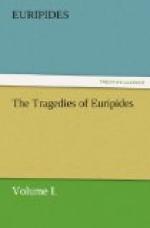[30] [Greek: akoe] is here to be understood in the sense of [Greek: akouomenon] as we find [Greek: aisthesis] for [Greek: aistheton], [Greek: nous] for [Greek: to nooumenon].
[31] The words [Greek: didymon potamon] do not refer to Dirce, but to Thebes, Thebes being called [Greek: polis dipotamos]. The construction is [Greek: pyrgos didymon potamon]. Thus in Pindar [Greek: oikema potamou] means [Greek: oikema para potamoi]. Olymp. 2. Antistr. 1.
[32] See note [D].
[32a] [Greek: goun]. See Dind.
[33] [Greek: ti gar patho]; Quid enim agam? est formula eorum, quos invitos natura vel fatum, vel quaecumque alia cogit necessitas. VALCKEN.
[34] [Greek: Prosegoreson] is to be joined with [Greek: molon], not with [Greek: eimi]. In confirmation of this see line 1011.
[35] So called after Neis the son of Amphion and Niobe, or from [Greek: neatai], “Newgate.” SCHOL.
[36] Argus himself might be called [Greek: stiktos], but not his eyes, hence [Greek: pyknois] is proposed by Heinsius. Abreschius receives [Greek: stiktois] in the sense of [Greek: hois stiktos esti].
[37] The Scholiast makes [Greek: bleponta] the accusative singular to agree with [Greek: panopten]. Musgrave takes it as agreeing with [Greek: ommata]; in this latter case [Greek: kryptonta] is used in a neuter signification. Note [F].
[38] This is Musgrave’s interpretation, by putting the stop after [Greek: hos], which also Porson adopts; others would join [Greek: hos] with [Greek: preson]. It seems however more natural that the torch should be referred to Tydeus’s emblem, than to himself.
[39] Commentators and interpreters are much at variance concerning the word [Greek: strophinxin]. For his better satisfaction on this passage the reader is referred to the Scholia.
[40] [Greek: geissa] is in apposition to [Greek: laan] in the preceding line. Cf. Orestes, 1585.
[41] Commentators are divided on the meaning of [Greek: enelata]. One Scholiast understands it to mean the uprights of the ladder in which the bars are fixed. Eustathias considers [Greek: enelaton bathra] a periphrasis for [Greek: bathra, enelata] being the [Greek: bathra] or [Greek: bathmides], which [Greek: enelelantai tois orthois xylois].
[42] Musgrave would render [Greek: hygrotet’ enantian] by “mobilitatem male coalescentem;” in this case it would indicate the bad omen, and be opposed to [Greek: akran lampada], which then should be translated “the pointed flame.” Valckenaer considers the passage as desperately corrupt. See Musgrave’s note. Cf. Note [G].
[43] If the flame was clear and vivid.
[44] If it terminated in smoke and blackness.
[45] The construction of this passage is the same as that of Il. [Greek: D] 155. [Greek: thanaton ny toi horki’ etamnon]. “Foedus, quod pepigi, tibi mortis causa est.” PORSON.




